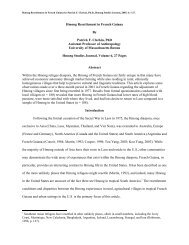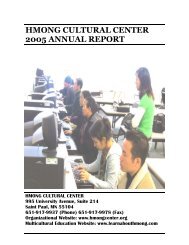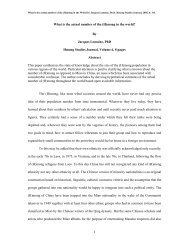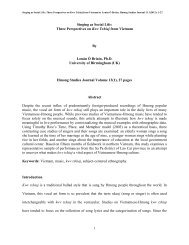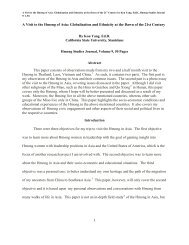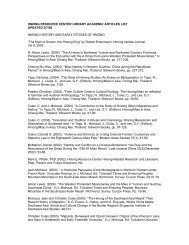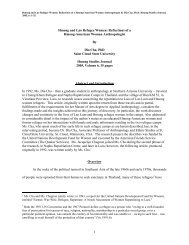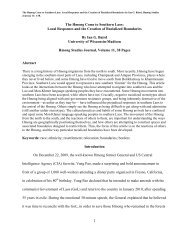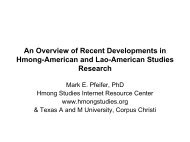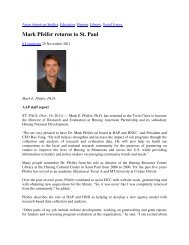A visit to the Hmong in Asia - Hmong Studies Internet Resource Center
A visit to the Hmong in Asia - Hmong Studies Internet Resource Center
A visit to the Hmong in Asia - Hmong Studies Internet Resource Center
Create successful ePaper yourself
Turn your PDF publications into a flip-book with our unique Google optimized e-Paper software.
A Visit <strong>to</strong> <strong>the</strong> <strong>Hmong</strong> of <strong>Asia</strong>: Globalization and Ethnicity at <strong>the</strong> Dawn of <strong>the</strong> 21 st Century<br />
Pho<strong>to</strong> Essay by Kou Yang<br />
Visit<strong>in</strong>g <strong>the</strong> urban <strong>Hmong</strong> <strong>in</strong><br />
Bangkok. From right <strong>to</strong> left, Taub<br />
and Prayath Nanthans<strong>in</strong>, and<br />
<strong>the</strong>ir friend, Bhakch<strong>in</strong><br />
Vachirathanakit. Prayath is a<br />
lecturer at Kasetsart University<br />
and his wife, Taub, is also college<br />
educated. Bhakch<strong>in</strong> is an<br />
<strong>Internet</strong> Technician. They<br />
represent <strong>the</strong> few <strong>Hmong</strong> who<br />
have <strong>the</strong> education and vocation<br />
<strong>to</strong> live a more comfortable urban<br />
life <strong>in</strong> Bangkok. It should be<br />
noted here that all of <strong>the</strong>m have<br />
Thai names (see endnote # 8).
The pho<strong>to</strong> above captures a scene <strong>in</strong> <strong>the</strong> <strong>to</strong>wn of Sayaboury, Laos where I grew up. Beh<strong>in</strong>d it is Pha Xang<br />
or Elephant Mounta<strong>in</strong> and <strong>the</strong> Nam Houng River, <strong>the</strong> landmarks of <strong>the</strong> <strong>to</strong>wn. Inserted (at left) is a<br />
portrait of myself <strong>in</strong> <strong>the</strong> early 1970s, when I was a Buddhist Novice of Sisavang Vong Buddhist<br />
Monastery. Inserted (right) is one of thousands of rubber trees that dom<strong>in</strong>ate <strong>the</strong> landscapes of many<br />
rural roads <strong>in</strong> Sayaboury.<br />
My old school: I was a member of <strong>the</strong> second cohort of this school, which was <strong>the</strong>n called <strong>the</strong> College de<br />
Sayaboury. Above is a pho<strong>to</strong> of myself and classmates <strong>in</strong> 1974. Below is a pho<strong>to</strong> taken dur<strong>in</strong>g <strong>the</strong> 2008<br />
<strong>visit</strong>; it is now Lycee de Sayaboury.
<strong>Hmong</strong> at <strong>the</strong> Morn<strong>in</strong>g Market <strong>in</strong> Sayaboury
Some newly rich <strong>Hmong</strong> <strong>in</strong> Sayaboury with <strong>the</strong> author.
A <strong>Hmong</strong> child (above) is watch<strong>in</strong>g <strong>the</strong> Lord of <strong>the</strong> R<strong>in</strong>gs<br />
Many <strong>Hmong</strong> homes have <strong>the</strong> TV satellite dish that allows <strong>the</strong>m <strong>to</strong> watch domestic as well as<br />
<strong>in</strong>ternational television programs<br />
Two welcome Home Baci Ceremonies offered <strong>to</strong> me by both my Lao and <strong>Hmong</strong> families. Left: my<br />
former Buddhist Teacher and his wife perform<strong>in</strong>g <strong>the</strong> welcom<strong>in</strong>g home Lao Baci ceremony for me. He<br />
resigned from his monkhood after I left Laos <strong>in</strong> 1975; he married and has three girls. S<strong>in</strong>ce he has no<br />
son, and I was his most cherished disciple, he made me his older god‐son and offered me a welcome
home ceremony. Right: my aunt and her family are perform<strong>in</strong>g <strong>the</strong> <strong>Hmong</strong> welcome home ceremony<br />
for me. These ceremonies represent my upbr<strong>in</strong>g<strong>in</strong>g and multicultural background.<br />
Most <strong>Hmong</strong> girls <strong>in</strong> Laos <strong>to</strong>day do<br />
not wear <strong>Hmong</strong> cloth<strong>in</strong>g <strong>in</strong> <strong>the</strong>ir<br />
everyday lives, but cont<strong>in</strong>ue <strong>to</strong> do <strong>the</strong><br />
Pa Ndau or embroidery.<br />
I enterta<strong>in</strong> <strong>Hmong</strong><br />
children <strong>in</strong> Ban Done<br />
That, Bokeo Prov<strong>in</strong>ce,<br />
Laos with a <strong>Hmong</strong><br />
folktale s<strong>to</strong>ry.<br />
Everyone I meet is<br />
both my student and<br />
teacher.
A <strong>Hmong</strong> girl <strong>in</strong> Ban Song Cha, Oudomxay, is watch<strong>in</strong>g <strong>the</strong> feed<strong>in</strong>g of her family’s pigs. Please note that<br />
she dresses <strong>in</strong> Lao cloth<strong>in</strong>g styles and holds a a cell phone <strong>in</strong> her hands, listen<strong>in</strong>g <strong>to</strong> <strong>Hmong</strong> American<br />
pop music. This is <strong>in</strong>deed a tradi<strong>to</strong>nal life with modern technology.
Globalization and high‐tech have reached many aspects of <strong>Hmong</strong> life. In <strong>the</strong> pho<strong>to</strong> above, an elderly<br />
<strong>Hmong</strong> woman is talk<strong>in</strong>g on <strong>the</strong> cell phone, probably <strong>to</strong> a relative out of <strong>to</strong>wn or <strong>in</strong> <strong>the</strong> US.<br />
The <strong>in</strong>fluence of <strong>Hmong</strong> Americans on <strong>the</strong> <strong>Hmong</strong> youth of Laos is very obvious. In this pho<strong>to</strong>, young<br />
<strong>Hmong</strong> <strong>in</strong> Ban Done That, Bokeo prov<strong>in</strong>ce, are exam<strong>in</strong><strong>in</strong>g DVDs of pop music and films made by <strong>Hmong</strong><br />
Americans.
Many of <strong>the</strong> young <strong>Hmong</strong> have no idea where California is, but for <strong>the</strong>m, wear<strong>in</strong>g California is <strong>the</strong> latest<br />
fashion.<br />
In this pho<strong>to</strong>, no one wears <strong>Hmong</strong><br />
costumes. They all come outside <strong>to</strong><br />
see a girl be<strong>in</strong>g sent <strong>to</strong> <strong>the</strong> hospital<br />
because of an attempted suicide.<br />
This is how <strong>the</strong>y dress <strong>in</strong> <strong>the</strong>ir every<br />
day life.
A scene of a <strong>Hmong</strong><br />
ghet<strong>to</strong> <strong>in</strong> Luang<br />
Prabang, which is<br />
sandwiched<br />
between <strong>the</strong> Luang<br />
Prabang<br />
International Airport<br />
and <strong>the</strong><br />
Souphanouvong<br />
University.<br />
This is <strong>the</strong> old Normal School,<br />
my old school <strong>in</strong> Luang<br />
Prabang. Above is a pho<strong>to</strong><br />
taken dur<strong>in</strong>g this trip and<br />
below is a pho<strong>to</strong> taken <strong>in</strong><br />
1975, when I was a student of<br />
this school
I was born on one of <strong>the</strong>se mounta<strong>in</strong>s<br />
The remnant of <strong>the</strong> bygone era <strong>in</strong> Sala Phou Khoun: This jeep was used by <strong>the</strong> Pa<strong>the</strong>t Lao dur<strong>in</strong>g <strong>the</strong><br />
transition of chang<strong>in</strong>g governments between 1974‐75. The last battle between <strong>the</strong> forces of Military<br />
Region II under <strong>the</strong> command of former Major Genral Vang Pao and <strong>the</strong> Lao People’s Army <strong>to</strong>ok place<br />
here <strong>in</strong> April <strong>in</strong> 1975.
A <strong>Hmong</strong> American <strong>visit</strong><strong>in</strong>g relatives<br />
<strong>in</strong> Phonsavanh, Xieng Khouang<br />
Prov<strong>in</strong>ce. On <strong>the</strong> right, a <strong>Hmong</strong> Lao<br />
is try<strong>in</strong>g <strong>to</strong> change Kip, Lao currency,<br />
with US dollars from <strong>the</strong> <strong>Hmong</strong><br />
American and his friend.<br />
My <strong>to</strong>ur of <strong>the</strong> Pla<strong>in</strong> of Jars, treasures of <strong>the</strong><br />
country of Laos. In this pla<strong>in</strong> lie many hundreds<br />
of Jars of various sizes, built by <strong>the</strong> aborig<strong>in</strong>es of<br />
Laos. My eyes are frozen on <strong>the</strong> bomb crater next<br />
<strong>to</strong> a group of priceless jars (<strong>in</strong>serted); many<br />
priceless jars may have already been destroyed. .<br />
His<strong>to</strong>ry has left both treasures and destruction.
The first grave on <strong>the</strong> left is that of Nhiavue<br />
Lobliayao, <strong>the</strong> second <strong>to</strong> <strong>the</strong> left, Lo Bliyao.<br />
Beh<strong>in</strong>d are <strong>the</strong> remnants of Lo Bliayao’s<br />
home, <strong>the</strong> only bricked and concreted <strong>Hmong</strong><br />
home <strong>in</strong> his time, so <strong>the</strong> <strong>Hmong</strong> called it Tsev<br />
Pob Zeb. Lo Bliayao, a paramount leader of<br />
<strong>the</strong> <strong>Hmong</strong>, died n 1932.<br />
Left <strong>to</strong> right: The graves of Ya<br />
Tho<strong>to</strong>u, Paseuth Fong Ya, and<br />
<strong>the</strong>ir Advisor, Viet Xuan Hung. All<br />
of <strong>the</strong>m were buried <strong>in</strong> Nong Het,<br />
Laos.
The <strong>to</strong>mb of Faydang Lobliyao <strong>in</strong> Nong Het<br />
Left: Attend<strong>in</strong>g a feast of <strong>the</strong> Yatho<strong>to</strong>u<br />
family <strong>in</strong> Muong Kham, <strong>the</strong> Rice Basket<br />
of Xieng Khouang prov<strong>in</strong>ce.<br />
Below: The sign of <strong>the</strong> village of<br />
Phakhae, <strong>the</strong> former terri<strong>to</strong>ry of Ly<br />
Foung. Touby Lyfoung’s official<br />
birthplace. The first <strong>Hmong</strong> village<br />
school was built near this village.
Top left: <strong>Hmong</strong> shopkeepers <strong>in</strong> Phonhsavanh, Xieng Khouang Prov<strong>in</strong>ce. Right: Western Union<br />
advertisement – show<strong>in</strong>g <strong>the</strong> <strong>in</strong>fluence of <strong>Hmong</strong> Americans send<strong>in</strong>g money <strong>to</strong> relatives <strong>in</strong> Laos.<br />
Above is a scene of <strong>the</strong> Mekong River, from <strong>the</strong> Thai side, North of Vientiane. Many thousand <strong>Hmong</strong><br />
refugees swam across this mighty river; while many safely reached refugee camps <strong>in</strong> Thailand, o<strong>the</strong>rs<br />
drowned and died.
Above is a pho<strong>to</strong> of a young <strong>Hmong</strong> bride and Lao<br />
groom be<strong>in</strong>g blessed by <strong>the</strong> bride’s fa<strong>the</strong>r, <strong>the</strong> Hon.<br />
Yathao Sailue, member of <strong>the</strong> Council of <strong>the</strong> Lao<br />
Front for National Reconstruction. Both <strong>the</strong> bride<br />
and <strong>the</strong> groom are from elite families <strong>in</strong> Vientiane.<br />
Left is H.E. Pani Yatho<strong>to</strong>u, member of <strong>the</strong> Politburo<br />
of <strong>the</strong> Lao Revolutionary Party and Vice President<br />
of <strong>the</strong> National Assembly of <strong>the</strong> Lao People’s<br />
Democratic Republic. She is <strong>the</strong> first woman <strong>in</strong><br />
Laos <strong>to</strong> have ever served <strong>in</strong> <strong>the</strong> Politburo and as<br />
Vice President of <strong>the</strong> National Assembly.
The above and below pho<strong>to</strong>s are examples of Sapa, Vietnam, <strong>the</strong> picturesque <strong>Hmong</strong> terrace rice paddy<br />
fields and villages that attract thousands of foreign <strong>visit</strong>ors <strong>to</strong> <strong>the</strong>se areas yearly.<br />
In this pho<strong>to</strong>, <strong>Hmong</strong> women are<br />
try<strong>in</strong>g <strong>to</strong> sell <strong>the</strong>ir Pa Ndau and gift<br />
items <strong>to</strong> <strong>to</strong>urists <strong>in</strong> Sapa. These<br />
<strong>in</strong>teractions lead <strong>to</strong> <strong>the</strong> acquisition of<br />
English among many young <strong>Hmong</strong>
Above is a scene of young <strong>Hmong</strong> <strong>in</strong> Sapa brows<strong>in</strong>g through <strong>the</strong> <strong>in</strong>ternet, mostly <strong>to</strong> <strong>Hmong</strong> American<br />
websites. Below is a group of <strong>Hmong</strong> <strong>to</strong>urist guides exam<strong>in</strong><strong>in</strong>g <strong>the</strong>ir newest <strong>to</strong>ys ‐ cell phones.
Above is a scene of a <strong>Hmong</strong> market place <strong>in</strong> Can Cau, Lao Cia, Vietnam. Below is a scene of <strong>Hmong</strong> men<br />
who come <strong>to</strong> <strong>the</strong> marketplace <strong>to</strong> socialize and dr<strong>in</strong>k. People come <strong>to</strong> <strong>the</strong> market by foot, bicycle,<br />
mo<strong>to</strong>rcycle or horseback.
Above is a pho<strong>to</strong> of an educated couple <strong>in</strong> Lao Cai. The husband is a teacher his wife is a student tra<strong>in</strong><strong>in</strong>g<br />
<strong>to</strong> be a teacher. They represent some of <strong>the</strong> very few who have made it <strong>to</strong> <strong>the</strong> vocational school <strong>in</strong><br />
Vietnam.
Above is a <strong>Hmong</strong> village <strong>in</strong> Kai Yuan, Yunnan, Ch<strong>in</strong>a. Below is a pho<strong>to</strong> of two <strong>Hmong</strong> teenagers, who<br />
have only a 9 th grade of educatuon. Smok<strong>in</strong>g appears <strong>to</strong> be very popular among <strong>Hmong</strong> youth <strong>in</strong> Yunnan,<br />
where <strong>the</strong> economy is heavily based upon tabacco production.
Above is a pho<strong>to</strong> of <strong>the</strong> urban <strong>Hmong</strong> <strong>in</strong> Mengzi , Ch<strong>in</strong>a, and <strong>the</strong>ir daily life. These two gentlemen run a<br />
car wash shop. Below is a pho<strong>to</strong> of my <strong>visit</strong> <strong>to</strong> <strong>the</strong> <strong>Hmong</strong> <strong>in</strong> Sichuan Prov<strong>in</strong>ce, Ch<strong>in</strong>a. Inserted is a<br />
portrait of a <strong>Hmong</strong> girl <strong>in</strong> Sichuan.
A group of <strong>Hmong</strong> elders <strong>in</strong> Sichuan welcome me with a Qeej performance. Inserted is a pho<strong>to</strong> of a<br />
<strong>Hmong</strong> girl <strong>in</strong> Gaopuo with her Qeej. The shape and form of <strong>the</strong> Qeej also are <strong>in</strong>dica<strong>to</strong>rs of language:<br />
<strong>the</strong> similarity of <strong>the</strong> Qeej shows <strong>the</strong> similarity of <strong>the</strong> language dialect. Note that this girl also calls herself<br />
<strong>Hmong</strong>.
Above are <strong>the</strong> remnants of Ban V<strong>in</strong>ai <strong>Hmong</strong> refugee camp <strong>in</strong> Thailand. Inserted is a pho<strong>to</strong> of statuettes<br />
built by <strong>Hmong</strong> Chao Fa from 1975 <strong>to</strong> 1990.<br />
Above is a desecrated <strong>Hmong</strong> grave <strong>in</strong> Tham Krabok, Thailand. Below is <strong>the</strong> marker of a <strong>Hmong</strong> grave<br />
that has been desecrated.
As of this writ<strong>in</strong>g, about 10 <strong>Hmong</strong> families rema<strong>in</strong> <strong>in</strong> Tham Krabok. This girl’s family is one of <strong>the</strong>m.<br />
Below are <strong>the</strong> rema<strong>in</strong>s of <strong>the</strong> old refugee camp <strong>in</strong> Tham Krabok.
©2008 Kou Yang<br />
Above, a <strong>Hmong</strong> assembly worker <strong>in</strong> her studio that she shares with three o<strong>the</strong>r girls. There is<br />
no cook<strong>in</strong>g s<strong>to</strong>ve and furniture. Inserted (bot<strong>to</strong>m left) is a scene of three <strong>Hmong</strong> assembly<br />
workers outside of <strong>the</strong>ir studio. Below is a sculpture of <strong>Hmong</strong> Qeej Masters <strong>in</strong> P<strong>in</strong>gpian Miao<br />
Au<strong>to</strong>nomous County, Hong He Prefecture, Yunnan Prov<strong>in</strong>ce, P.R. Ch<strong>in</strong>a.




